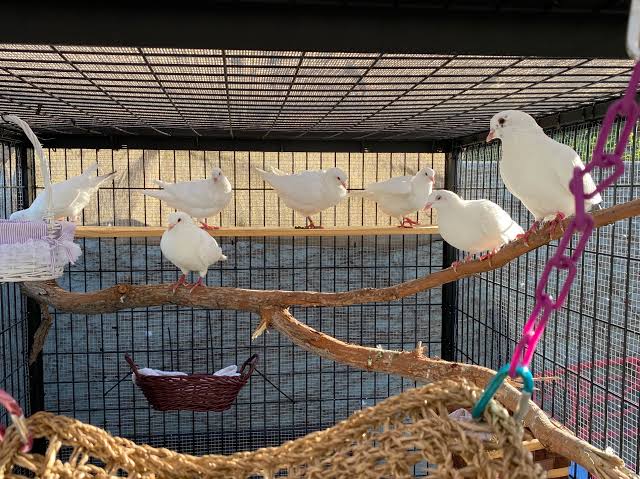
DIY Bird Cages: Safe and Comfortable Designs
This article guides bird enthusiasts through the process of designing and building their own bird cages. It emphasizes safety considerations, appropriate materials, cage size and design, and enrichment ideas to ensure a comfortable and stimulating environment for pet birds.
🐶 Pet Star
15 min read · 1, Feb 2025

Why DIY? The Benefits of Building Your Own Bird Cage
Now, why would you want to build your own bird cage, you ask? Well, my dear, there are many reasons! First, you have complete control over the size and design. You can create a cage that perfectly fits your bird's needs and your home's décor. Second, it can be a fun and rewarding project! There's nothing quite like the satisfaction of building something with your own hands. And third, it can often be more affordable than buying a pre-made cage, especially if you're looking for a larger or more customized design.
Safety First: Essential Considerations for Bird Cage Construction
But, my dear, safety is paramount! You must prioritize your bird's well-being above all else. Choose materials that are non-toxic and safe for birds. Avoid anything that could be chewed or ingested, as some woods and metals can be harmful. Stainless steel or powder-coated metal are excellent choices for the cage bars. For the base, you can use a sturdy plastic tray or a metal pan. Avoid using galvanized metal, as it can contain zinc, which is toxic to birds.
Choosing the Right Materials: Non-Toxic and Durable Options
And speaking of materials, let's talk specifics. Hardwoods like maple or beech are generally safe for perches, but avoid treated lumber. Natural branches from fruit trees are also great, but make sure they haven't been sprayed with pesticides. For the cage structure, you can use wood, metal, or a combination of both. Just ensure all materials are sturdy and free from any harmful chemicals.
Cage Size and Design: Providing Ample Space and Stimulation
Now, size matters! Your bird needs enough space to spread its wings, fly a short distance, and move around comfortably. The general rule of thumb is that the cage should be at least twice as wide and twice as tall as your bird's wingspan. Consider your bird's species and activity level when determining the appropriate size. And don't forget about vertical space! Birds love to climb, so provide them with perches at different heights.
Enrichment is Key: Creating a Stimulating Environment
A cage shouldn't just be a place to eat and sleep; it should be a stimulating environment that encourages natural behaviors. Provide your bird with a variety of toys, such as swings, ladders, and chew toys. Rotate the toys regularly to keep things interesting. You can also add foraging toys that require your bird to work for its food, which provides mental enrichment.
Step-by-Step Guide: Building Your DIY Bird Cage (General Outline)
Building a bird cage is a project that requires careful planning and execution. First, sketch out your design, taking into account the size and needs of your bird. Gather your materials and tools. Cut the wood or metal to the desired dimensions. Assemble the cage structure, ensuring everything is securely fastened. Install the cage bars, spacing them appropriately to prevent your bird from escaping. Add the perches, toys, and food and water dishes.
Tips and Tricks for Successful Bird Cage Construction
Here are a few tips to keep in mind: Always double-check your measurements before cutting any materials. Use rust-resistant hardware to prevent corrosion. Smooth any sharp edges or corners to prevent injuries. And most importantly, be patient and take your time.
Maintaining Your DIY Bird Cage: Cleaning and Upkeep
Once your bird cage is built, it's important to keep it clean and well-maintained. Regularly clean the cage base and replace the lining. Wipe down the cage bars and perches. Wash the food and water dishes daily. And inspect the cage regularly for any signs of damage or wear.
A Happy Bird is a Healthy Bird: The Importance of a Comfortable Home
Remember, my dear grandson, a happy bird is a healthy bird. By creating a safe, comfortable, and stimulating environment, you're providing your feathered friend with the best possible home. It's an act of love, a way to show them how much you care.
Q&A Section:
Q1: What kind of wood is safe for bird cages?
Ans: Hardwoods like maple, beech, and fruit tree branches (unsprayed) are generally safe. Avoid softwoods like pine or cedar, as they can contain harmful oils. Always research specific wood types before using them.
Q2: How do I clean a bird cage safely?
Ans: Use a mild dish soap and warm water to clean the cage. Rinse thoroughly to remove any soap residue. Avoid using harsh chemicals or cleaning products, as they can be toxic to birds.
Q3: How often should I clean my bird's cage?
Ans: Daily cleaning of the food and water dishes is essential. The cage base should be cleaned every 1-2 days, and a more thorough cleaning of the entire cage should be done weekly.
Q4: What are some signs that my bird is unhappy in its cage?
Ans: Signs of an unhappy bird include feather plucking, excessive vocalization, lethargy, loss of appetite, and changes in droppings. If you notice any of these signs, consult with an avian veterinarian.
Q5: Where can I find inspiration for DIY bird cage designs?
Ans: You can find inspiration online through websites like Pinterest, bird forums, and DIY websites. Just be sure to prioritize safety and functionality when adapting any design.
Similar Articles
Find more relatable content in similar Articles
Explore Other Categories
© 2024 Copyrights by rPets. All Rights Reserved.